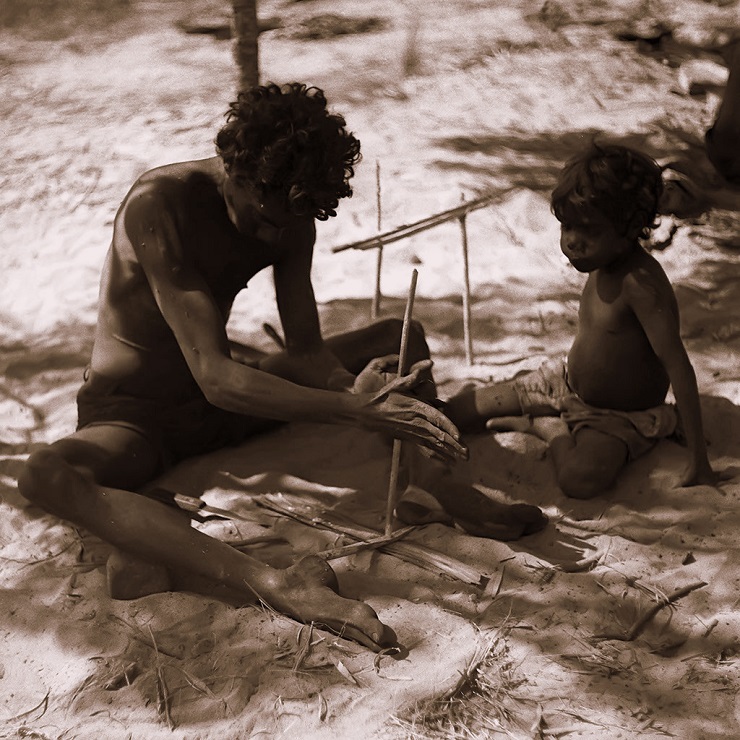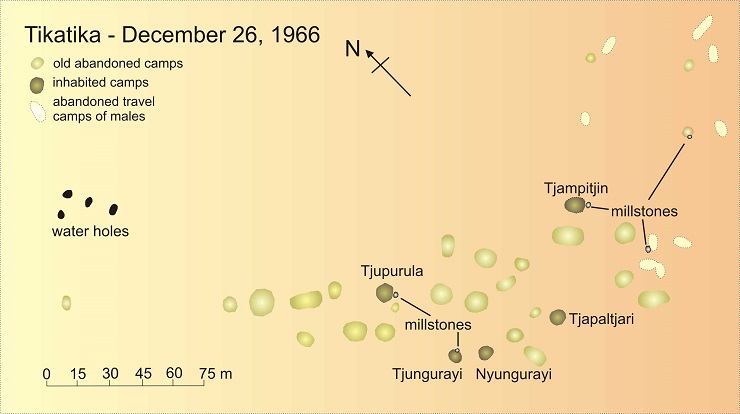In the 1960’s the American ethnoarchaeologist Richard Gould chose to study the settlement behaviour of Aborigines at a residential camp in the desert of Western Australia located in a shallow basin called Tikatika. This location was inhabited by thirteen Aborigines who all spoke the Ngatatjara language. The natives had chosen the Tikatika site based on its close-by and sustainable water supply. These naturally- formed wells comprised several holes in the ground containing water at a depth of about two and a half metres below the surface.
The camp was located cca. 180 metres to the southeast of the well and comprised several smaller components including windscreens made from branches of mulga tree, stuck together in an oval shape. In this area the natives kept the ground clean and it was also where their fireplaces were located. Beside each of the larger windscreens there was a large lower mill and one or two smaller upper mills. The entire area of the camp was devoid of grass so that fearsome reptiles could not hide in it.
How did one of these days look to the hunter-gatherer group that Richard Gould also described in 1966? In the morning, at their family campsite, people fed themselves on the food that remained from the previous day. After this they prepared tea in a pot that represented a European cultural import. For breakfast, each group ate the same food: sticky lumps of kampurarpa fruit (Solanum centrale) and dried pods of numun-gurra (Solanum chippendalei). The area around Tikatika was relatively poor in terms of its incidence of wildlife; birds, kangaroos, emus and many reptiles and bandicoot marsupials did live there however. Both the men and the women left the camp in the morning in order to enrich their diet with the meat of animals. Their journey continued separately, however, and the children and the dogs went with the women. The men concentrated on hunting and if they found some edible fruits they consumed them on the spot. In contrast, the women collected a significant amount of fruit that they carried in bowls on their heads and transported to the camp while later crushing them to pulp on stone grinders. But even the women would also occasionally engage in hunting animals. In the evening these animals were roasted on hot coals and eaten and the women then ground the skin and the bones on stone platforms. In this way all the edible parts of the hunted animals were utilised.
Australian hunter-gatherers had their territory mapped-out precisely in terms of its usable natural resources. They knew where and at what time of the day and year to obtain food - just as Euro-American women know where in the supermarket they will be certain find the essential goods. If the anticipated prevalence of food sources was not confirmed, the indigenous women always had an alternative site up their sleeves. From time to time they also set off on an exploratory expedition into as yet unknown areas.
|
|
|
About five months after the period described in this chapter Richard Gould revisited the now already abandoned Tikatika camp to monitor the impact of the natural environment on the preservation of the original settlement activities. Individual family campgrounds were still evident on the site, though obviously less evident than while it was inhabited. The wind had also churned-up the previously swept areas of the camps and had scattered the ashes from the fireplaces outside them. The windbreaks were already severely damaged and had ceased to perform their function. New grass was sprouting throughout the entire area, including the central area of the camp, while the water source was contaminated with leaves and branches. As a permanent proof of the previous human presence, remaining there were large flat bottom grinding stones and scattered stone flakes, together with tools that had also been discarded in the vicinity of the camp. It is these previously mentioned small stone artefacts that represent a somewhat perplexing factor. That is because industrial activity had increased on the site during the repeated though intermittent seasonal presence of the hunter-gatherer groups. In addition, during a period in which the camp was deserted, the wind had uncovered a sequence of stone artefacts that were not visible during the period of the settlement of the site (a ratio of cca. 8:1 in favour of the observations implemented in what was already an abandoned camp). |
 |
| An Australian hunter throws a spear using a woomera thrower. This aid extends the hunter’s arm so that the spear flies further and has a greater depth of penetration. Additionally, the woomera was a multifunctional tool because its flat shape also predestined its use as a bowl. A stone tip, serving as a knife or a chisel, was attached to the lower end of the woomera. Photo from the Moravian Land Museum’s Australian expedition in 1969. |
 |
| The young man is starting a fire by rubbing sticks together. He is able to blow the flames from the tinder within a minute of initiating this activity. Photos from the Moravian Land Museum’s Australian expedition in 1969. |
 |
| A baked reptile is portioned using stone tools. Photos from the Moravian Land Museum’s Australian expedition in 1969. |
 |
| Scattered groups of natives in northwestern Australia meet together from time to time in the ceremonial festivities that are called corroboree. This event also included ritual interactions with the mythical Time of Dreams, which were presented through music, dance and special costumes. Illustration by Petr Modlitba. |
Want to learn more?
- Gould, R. A. 1978. From Tasmania to Tucson: New Direction in Ethnoarchaeology. In Explorations in Ethnoarchaeology, ed. R. Gould, 1-10. Albuquerque: University of New Mexico Press.
- Gould, R. A. 1980. Living archaeology. New York: Cambridge University Press.
 Archeologické 3D virtuální muzeum
Archeologické 3D virtuální muzeum

.jpg)
